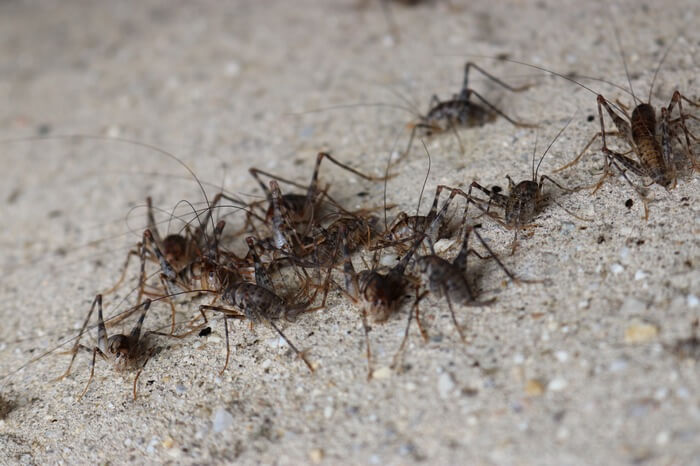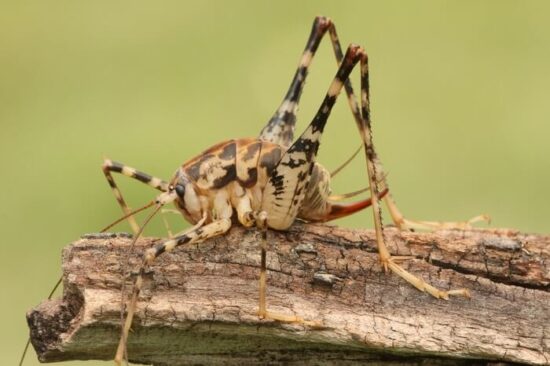Knowing how to get rid of spider crickets is very important if you’re a homeowner (especially if you have a basement). These insects are more than just creepy-looking, they can also damage various items in your house.
This guide will teach you how to get rid of camel crickets and prevent them from coming back.
Table of contents
What Are Spider Crickets?
The name “spider cricket” is enough to send shivers down a person’s spine. As their common name would imply, these insects look like a cross between a cricket and a spider. But technically speaking, they’re neither.
Also known as cave cricket and camel cricket, this insect belongs to an order called Orthoptera. It’s the same order that locusts and grasshoppers belong to. When you see the spider cricket up close, the resemblance is unmistakable.

The most defining feature is the large back legs, which these bugs use to leap great lengths. The other legs are pretty long, too. Pair that with the long needle-like antennae, and it’s no wonder why so many people mistake these insects for spiders (and why they’re so eager to get rid of them).
The body is about an inch and a half long and has segmented armor-like plates. The arrangement of those plates creates a distinct, semicircular hump, which is probably why some people call them camel crickets. Most cave crickets are brown and have sporadic splotches of black all over the body.
The spider cricket is a somewhat elusive insect. Unlike actual crickets, this critter doesn’t chirp or make any noise. As a result, the only way you’re made aware of their presence is to see them.
Quick Tip: Sightings can be very alarming. Instead of scurrying out of the way as most bugs do, this one will show some bravado. It has a penchant for leaping directly at you before fleeing!
What Are They Attracted To?
Spider crickets are predominantly attracted to humid, cave-like settings. Dark and dingy basements, garages, and the space under raised foundations are their main draw.
In the wild, you’re most likely to see them hiding beneath some damp leaves or inside a rotten lock. Anywhere that’s slightly moist and muggy is ideal.
Quick Tip: This insect can appear all over the United States, and some species occur in Asia. However, you’re most likely to encounter spider crickets if you live east of the Mississippi River.
They thrive in damp wooded areas near water. High-humidity environments support their lifestyle best, so a migration to muggy basements is a natural one. In fact, if you want to get rid of spider crickets this is often the first place you should start with.
Camel crickets typically look for indoor shelter at the start of the Autumn season. The temperature drops, and humidity levels steadily decline as the weather gets cooler. The insect migrates to homes to escape the changing environment.
They’re also on the hunt for food!
Spider crickets are tried and true omnivores. They’ll eat just about anything, and that includes other crickets!
They also seem to gravitate towards softer items like clothes. If you’re unlucky enough to find these creatures in your closet, there’s a good chance that your clothing is already riddled with tears and holes.
Spider crickets also consume fungus, carpet fibers, cardboard, wood, and much more. All of their most common food sources are readily available in your house, which is why they like to set up shop during the colder months.
Once inside, they can wreak havoc on your house! Not only that, but they can lay eggs that will hatch in the spring. That’s why it’s so important to learn how to get rid of spider crickets quickly.
How To Get Rid Of Spider Crickets
Dealing with a spider cricket infestation is not fun. It doesn’t take long for these bugs to multiply and become a massive nuisance in your home. They’re not a pest you want to ignore.
The good news is that several effective treatment options are available. If you keep these in mind, you should be able to get rid of spider crickets without any problems.
1. Clean Up The Area
One of the first things you should do when you see a spider cricket is to take a look around and see how messy the area is. Chances are, it’s pretty cluttered.
Loose items strewn all over the floor are the perfect hiding spot for these insects. Clutter creates tons of warmth while also providing ample protection from light.
Taking some time to clean up the area should be the first thing you do when getting rid of spider crickets. Declutter as much as possible and remove all the unnecessary junk you don’t need. Then, put the vacuum to good work!
Your vacuum cleaner can do wonders to pick up cave crickets and their eggs. It’s impossible to get all of them in one cleaning session, but taking the time out of your weekly schedule to vacuum will do a lot to reduce the cricket population.
Quick Tip: After you vacuum, make sure to empty out the container and toss the bugs in the garbage outside to prevent them from spreading.
2. Place Traps
Like we said earlier, spider crickets are elusive. They hide in the dark and navigate your home under cover of shadows. It’s only when you startle them that they go on the defense and leap in your direction. All other moments, they’re traveling undetected.
If you see one camel cricket, there’s a good chance that even more lurk where you can’t see!
That means one of the best ways to get rid of spider crickets is to set up a few traps.
Your best bet is to try sticky traps. Invest in a few different types of glue-based traps to cover your bases. Pick up some unrollable tape, large sheets, and hanging tubes. Then, set them up in the area where you spotted the bugs previously.
The traps work by preventing escape. When the bug makes contact with the glue, it instantly holds them down until they starve to death.
Quick Tip: If you want to go the extra mile, try placing some bait food in the middle of the trap. Something as simple as moldy bread will be enough to entice the spider crickets to crawl onto the trap.
In addition to commercial glue traps, you can try DIY-friendly ones. Some homeowners have seen success creating basic duct tape traps. They’re supposed to work like glue traps, but they hardly have the same efficiency.
A better alternative would be a soap trap. Fill a large container up with water and add a few drops of dish soap. The water will draw the bugs in for a drink. Meanwhile, the soap is slippery enough to cause them to fall in and drown!
3. Sprinkle Delta Dust
Another super effective way to get rid of camel crickets is to spread delta dust, which is also known as deltamethrin dust. The fine powder is a popular insecticide that you can use to treat crawl spaces, basements, and wall voids.
It has a consistency similar to baby powder, so it’s easy to spread. When you apply it, the powder will quickly stick to walls, floors, and ceilings. It’s relatively water-resistant. As a result, the powder is perfect for the humid environments these bugs like to inhabit.
Deltamethrin works by attacking the insect’s central nervous system. It coats the entire body and prevents the insect from performing essential bodily functions to survive. Before long, the spider cricket will suffocate and die.
Delta dust can get rid of adult spider crickets hiding in hard-to-reach spaces. It also kills nesting insects and any hatched young. The product doesn’t always kill eggs, but the long-lasting nature of the dust ensures that it will kill the hatchlings when they emerge.
Quick Tip: You don’t need much delta dust to make an impact. A pound of it will easily treat 500 to 1,000 square feet. That’s more than enough to cover most basements.
4. Use A Spray
Liquid sprays can work to kill and get rid of spider crickets as well. To have the greatest impact, apply insecticide sprays both inside and outside.
For the exterior of your home, try using something like Bithor. It’s a low-odor concentrate that you can easily dilute with some water. Bithor is a mix of several chemical insecticides, resulting in high potency that can kill more than 100 different pests.
Dilute the spray according to the instructions. Then, apply it liberally around potential entry points. Pay extra attention to the foundation’s walls, windows, and doorways.
Bithor lasts about a month, so you’ll need to reapply to maintain its repelling efficiency.
For the inside of your home, any interior spray will work. Permethrin-based solutions tend to be the most popular.
Once again, focus on all potential entry points and hiding spots. Spray the area you saw the bugs in first. Then, move onto nearby areas to provide as much coverage as possible.
Use protection when applying any form of a spray. For indoor insecticides, clear the room and let the smell ventilate out before having kids and pets come in.
5. Reduce Humidity
We already know that spider crickets love to live in humid areas. So, why not eliminate that qualifier entirely?
Invest in a robust dehumidifier and put it to good use! The machine will pull moisture from the air to make it feel less muggy and damp. The air will become crisp, which is counterintuitive to the camel cricket’s lifestyle.
Hopefully, that’s enough to encourage them to leave on their own accord. Most cave crickets will try to find more suitable living conditions instead of “roughing it” in low-humidity rooms.
There are plenty of great dehumidifiers on the market. Several are made explicitly for basements. They tend to have special features like automatic drainage and humidity monitors.
Quick Tip: Make sure to get a machine that’s rated to handle the size of the space. A small dehumidifier will barely register a change in a large basement.
6. Seal Exterior Openings
Finally, go around your home’s exterior and start sealing every possible entry point spider crickets can use to get in. Even after you get rid of the ones living inside your home, there’s a chance that more can enter. Sealing those access points will keep them out!
Look for small cracks and voids. Inspect the foundation closely. If you see a crack, seal it up with the appropriate product!
Caulk sealant provides quick results. However, stone facades may fare better with something like stucco or concrete filler.
Once you eliminate all structural voids, focus your attention on windows and doors. You can use sealant to make those openings airtight. Weatherstripping is also available for the lower levels.
Weatherstripping lets you maintain the function of the window or door while adding tons of extra protection. Take full advantage of it where necessary!
Are They Dangerous?
Those who have had to dodge a leaping spider cricket know that these critters are intimidating. But are they dangerous?
Interestingly enough, spider crickets usually don’t bite humans. However, they can cause some accidental pain.
These insects have mouths that are built for chewing on rigid materials like paper and fiber. Pair that with their readiness to eat just about anything, and spider crickets will often chew on the skin when they land on you.
The gnawing isn’t particularly dangerous as most instances don’t break the skin at all, but it can be very uncomfortable.
More giant spider crickets might even leave behind painful sores! The spot they chew on can turn red, slightly inflamed, and itchy. Fortunately, these guys will try to scare you with a leap before running out of harm’s way.
For the most part, camel crickets are harmless to humans. However, that doesn’t mean that you shouldn’t get rid of them.
Spider crickets enter your home with the sole purpose of having enough protection to lay eggs. They’re using your home as a nest to increase the insect population and ensure lasting survival.
Unfortunately, spider cricket numbers can skyrocket pretty quickly. Before you know it, you’ll have tons of little pests chewing on surfaces and ruining all of your items. Your closets and bookshelves will suffer greatly.
On top of all that, these pests leave behind a lot of waste. That’s the thing you have to be wary of.
Camel cricket feces can potentially spread disease. While this is rare, it’s still possible. The chances of you or your family getting sick from touching bug droppings go up exponentially the more you ignore the problem and let these insects spread. That’s why camel cricket control is so important.
Closing Thoughts
Now that you know how to get rid of spider crickets, you can see that these insects look more intimidating than they are. You definitely need to control them, place traps, and do some cleaning, but an infestation isn’t the worst thing in the world.
As long as you follow this guide and use the methods we recommended, you’ll be just fine!


